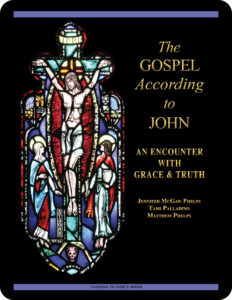 The Gospel According to John:
The Gospel According to John:
An Encounter with Grace & Truth
Lesson 25 Do You Love Me?
the Gospel According to John 20:19—21:25
Revised Standard Version Catholic Edition (RSVCE)*
New American Bible Revised Edition (NABRE)*
Catechism of the Catholic Church
ex libris (in our library)
glossary for the Gospel According to John
cross references in the Gospel According to John
This material coordinates with Lesson 25 on pages 130–135 in The Gospel According to John: An Encounter with Grace & Truth.
“Now Jesus did many other signs in the presence of the disciples, which are not written in this book; but these are written that you may believe that Jesus is the Christ, the Son of God, and that believing you may have life in his name.”—the Gospel According to John 20:30–31
welcome to our in-depth study of the Gospel According to John
We invite interested groups and individuals to check out the sample first lesson from this 25- lesson Turning to
lesson Turning to  God’s Word Catholic Bible study. These online study pages link to our free lesson videos, as well as to a glossary and cross references in the biblical text. Other study aids include maps, additional commentary, and prayers based on the primary Scripture in each lesson. The Gospel According to John: An Encounter with Grace & Truth has been granted an imprimatur and can be purchased from our website shop. If you have a Bible-related question or comment, click on one of the “ask us your question” or “what do you think” buttons on any online study page.
God’s Word Catholic Bible study. These online study pages link to our free lesson videos, as well as to a glossary and cross references in the biblical text. Other study aids include maps, additional commentary, and prayers based on the primary Scripture in each lesson. The Gospel According to John: An Encounter with Grace & Truth has been granted an imprimatur and can be purchased from our website shop. If you have a Bible-related question or comment, click on one of the “ask us your question” or “what do you think” buttons on any online study page.
open with prayer
It’s always wise to begin any Bible study with prayer, whether reading the Scriptures alone or meeting with others in a discussion study group. You can pray using your own words or use one of the opening prayers on our website. We especially like the following:
Lord Jesus, you promised to send your Holy Spirit
to teach us all things.
As we read and study your word today,
allow it to touch our hearts and change our lives. Amen.
let’s review—the Gospel According to John 20:1–18
In Lesson 24 Woman, Why Are You Weeping? Mary Magdalene, whose only previous appearance in the Fourth Gospel was at the Crucifixion, goes to the tomb early on the first day of the week where she discovers the stone rolled away. She runs to tell the disciples, and Simon Peter and the disciple whom Jesus loved (the Evangelist) run back to the tomb where they see the burial cloths. Although the disciples don’t yet know that Jesus has risen from the dead, the Evangelist nevertheless believes. After they left, Mary Magdalene remains outside the tomb weeping. Two angels appear where the body of Jesus had been, and they ask her why she is weeping. She replies and then sees Jesus, whom she mistakes for the gardener until Jesus calls her by name. Jesus refuses to allow Mary to hold him because he hasn’t yet ascended to the Father. Jesus instructs Mary to tell the disciples that he’s ascending, which Mary does.
map notes—one final visit to Galilee
Although the twentieth chapter in the Gospel According to John describes the risen Jesus appearing to his disciples in a locked room somewhere in Jerusalem or the near vicinity, in the twenty-first chapter in the Gospel According to John 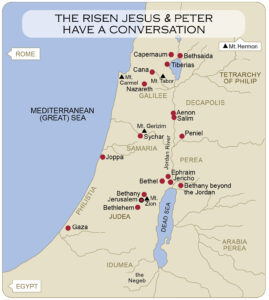 Jesus’ disciples have returned to the district of Galilee in the north. Not only that, but the disciples—at Simon Peter’s suggestion—have gone back to what was for many of them their former way of life as fishermen. It’s at this point in the Fourth Gospel that Jesus appears to them one final time at the Sea of Tiberias to point them toward their vocation as the first apostles who are responsible for establishing the Church. For more information about the significance of the location in Galilee where this happens, read “Deja Vu at the Sea of Tiberias” on page 135 in The Gospel According to John: An Encounter with Grace & Truth. Click on the image (right) to enlarge the map, which appears on page 132 in the study book.
Jesus’ disciples have returned to the district of Galilee in the north. Not only that, but the disciples—at Simon Peter’s suggestion—have gone back to what was for many of them their former way of life as fishermen. It’s at this point in the Fourth Gospel that Jesus appears to them one final time at the Sea of Tiberias to point them toward their vocation as the first apostles who are responsible for establishing the Church. For more information about the significance of the location in Galilee where this happens, read “Deja Vu at the Sea of Tiberias” on page 135 in The Gospel According to John: An Encounter with Grace & Truth. Click on the image (right) to enlarge the map, which appears on page 132 in the study book.
 everything is about love (01:05:56)
everything is about love (01:05:56)
In the video for this lesson, Turning to God’s Word author Matthew Phelps  discusses the two conclusions to the Gospel According to John—the twentieth chapter and the twenty-first chapter. In both cases, the Fourth Gospel concludes with the author providing information linking faith and love. It’s certainly significant that the Evangelist doesn’t bring up the idea of forgiveness until after Jesus’ Ascension. Can you locate when the Evangelist has previously indicated that Jesus’ Ascension already has occurred? To learn how forgiveness is tied to love, you can read “Forgive” on page
discusses the two conclusions to the Gospel According to John—the twentieth chapter and the twenty-first chapter. In both cases, the Fourth Gospel concludes with the author providing information linking faith and love. It’s certainly significant that the Evangelist doesn’t bring up the idea of forgiveness until after Jesus’ Ascension. Can you locate when the Evangelist has previously indicated that Jesus’ Ascension already has occurred? To learn how forgiveness is tied to love, you can read “Forgive” on page  132 in The Gospel According to John: An Encounter with Grace & Truth. When have you experienced the benefits of loving forgiveness? Were you giving or receiving?
132 in The Gospel According to John: An Encounter with Grace & Truth. When have you experienced the benefits of loving forgiveness? Were you giving or receiving?
The Scripture ranges for the videos that accompany this Catholic Bible study match the Scripture ranges for the sets of questions in The Gospel According to John: An Encounter with Grace & Truth. You can follow along with the video overview as Turning to God’s Word author Matthew Phelps discusses Lesson 25, “Do You Love Me?” on pages 130–135 in the study book.
WHAT’S GOING ON with the catch of fish?
Scholars suggest significance related to the catch of fish in the Fourth Gospel. Also, the Fourth Gospel concludes in quite a different manner than the three synoptic Gospels.
? Where in the Gospel According to Luke is there mention of Jesus instructing the disciples about the best place to cast their nets for fish? If necessary, see the Gospel According to Luke 5:1–11.
? At what point in Jesus’ ministry does this occur?
 ? What might account for the timing discrepancy between the Fourth Gospel and the synoptic accounts?
? What might account for the timing discrepancy between the Fourth Gospel and the synoptic accounts?
? What’s similar about the timing, and what does this suggest is important to the Evangelist John?
? What other differences can be seen between the Gospel According to John and synoptic Gospels According to Matthew, Mark, and Luke?
? What explanation might account for these differences?
? What purpose is it likely that the Evangelist John had in mind when he wrote the Fourth Gospel?
? What purpose might each of the other Evangelists had in mind when they were writing their Gospels?
is there a bit of rivalry between Peter & John?
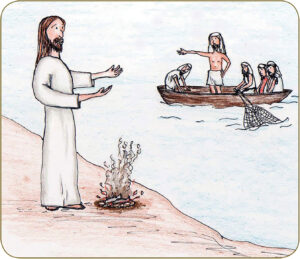 The twenty-first chapter in the Gospel According to John hints at an idea that perhaps Peter and John were competing for Jesus’ attention. In the Gospel According to John 21:21, after Peter has learned how he’s going to die for the glory of God, Peter asks Jesus about what’s going to happen to John. What’s suggested by the Evangelist’s record of this conversation? What does Jesus’ response indicate about how he feels about rivalry among his disciples? For more information, read “Even More About Peter & John” on page 134 in The Gospel According to John: An Encounter with Grace & Truth. (Turning to God’s Word co-founder Tami Palladino’s illustration of Jesus at the Sea of Tiberius appears on the map, “Key Events in the Gospel According to John,” on page 146, the back page of the study book.)
The twenty-first chapter in the Gospel According to John hints at an idea that perhaps Peter and John were competing for Jesus’ attention. In the Gospel According to John 21:21, after Peter has learned how he’s going to die for the glory of God, Peter asks Jesus about what’s going to happen to John. What’s suggested by the Evangelist’s record of this conversation? What does Jesus’ response indicate about how he feels about rivalry among his disciples? For more information, read “Even More About Peter & John” on page 134 in The Gospel According to John: An Encounter with Grace & Truth. (Turning to God’s Word co-founder Tami Palladino’s illustration of Jesus at the Sea of Tiberius appears on the map, “Key Events in the Gospel According to John,” on page 146, the back page of the study book.)
WHAT DO YOU THINK that Jesus is asking of Peter?
In the Gospel According to John 21:15–17, the similarity in Jesus’ responses to Peter’s three professions of love is that in all three cases Peter is asked to care for lambs or sheep, the job of a shepherd.
? Peter’s job before becoming a disciple of Jesus was as a fisherman. Why might  Jesus now be asking Peter to change roles?
Jesus now be asking Peter to change roles?
? Whom might Jesus consider to be lambs?
? Whom might Jesus consider sheep?
? Consider why Jesus specifies the two different categories.
? What kind of shepherd is it likely that Jesus expects Peter to be?
? In the Fourth Gospel, what has Jesus previously had to say about shepherds? If necessary refer to the tenth chapter in the Gospel According to John and the online study page for Lesson 13 I Am the Good Shepherd.
philia & agape—you could look these up in our archives
 The Beatles got it right—all you need is love, love, love. Love is all you need. The conclusion of the Fourth Gospel refers to several types of love, but distinctions in the original language disappear in English. To learn about philia and agape, read Lost in Translation, an online column in which Turning to God’s Word author Matthew Phelps helps readers connect with ideas expressed in the original languages of the Scriptures. New Lost in Translation entries are posted on Mondays, and past entries are archived on our website. Contact us if you’d like to receive Lost in Translation by email every week.
The Beatles got it right—all you need is love, love, love. Love is all you need. The conclusion of the Fourth Gospel refers to several types of love, but distinctions in the original language disappear in English. To learn about philia and agape, read Lost in Translation, an online column in which Turning to God’s Word author Matthew Phelps helps readers connect with ideas expressed in the original languages of the Scriptures. New Lost in Translation entries are posted on Mondays, and past entries are archived on our website. Contact us if you’d like to receive Lost in Translation by email every week.
ex libris—this book goes into great detail about what love is
I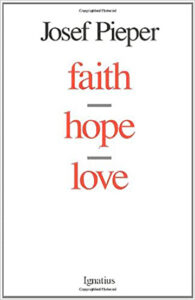 f you have any interest at all in the theological virtues of faith, hope, and love, it will
f you have any interest at all in the theological virtues of faith, hope, and love, it will  behoove you to consider Faith Hope Love by the philosophical writer Josef Pieper. You can check out our ex libris—main bookshelf entry to read a short review and brief excerpt from the book. Pieper’s small volume consists of three sections in which he relies on etymology to examine linguistic clues that shed light on the underlying meaning of each of the theological virtues. The result is surprisingly helpful information that has many practical applications for Christians.
behoove you to consider Faith Hope Love by the philosophical writer Josef Pieper. You can check out our ex libris—main bookshelf entry to read a short review and brief excerpt from the book. Pieper’s small volume consists of three sections in which he relies on etymology to examine linguistic clues that shed light on the underlying meaning of each of the theological virtues. The result is surprisingly helpful information that has many practical applications for Christians.
 the popes inspire us—human weakness
the popes inspire us—human weakness
The papal quote on page 133 in The Gospel According to John: An Encounter with Grace & Truth is by Pope Benedict XVI. In it, the Holy Father reflects on the biblical text upon which this lesson is based in order to teach about the character of Peter. The Pope teaches that Peter’s actions demonstrate that the school of faith isn’t a triumphal journey but a journey that’s daily marked by suffering and love, trials and faithfulness.
WHAT DO YOU THINK about this Catholic Bible study?
Send us an email to share your experience studying The Gospel According to John: An Encounter with Grace & Truth. We’d love to hear from you.
? Which passage from the Gospel According to John did you find to be the  most relevant in your life, and why?
most relevant in your life, and why?
? How have your ideas about the Catholic faith changed as a result of studying The Gospel According to John: An Encounter with Grace & Truth?
? What’s one unexpected way that this Bible study has touched your life?
? What’s something you’ve learned from studying the Gospel According to John that you’d like to share with others?
? To whom would you like to recommend The Gospel According to John: An Encounter with Grace & Truth?
? What book of the Bible would you like to study next, and why?
the best Catholic commentary about Scripture
 To find out more about how Church teaching is supported by Scripture passages in The Gospel According to John: An Encounter with Grace & Truth, check out the Index of Citations in the Catechism of the Catholic Church. Links to the primary Scripture passages in the lesson (Revised Standard Version Catholic Edition [RSVCE*]) and relevant paragraphs in the Catechism are provided here. Not every passage in the biblical text for this study is referenced in a Catechism paragraph, however.
To find out more about how Church teaching is supported by Scripture passages in The Gospel According to John: An Encounter with Grace & Truth, check out the Index of Citations in the Catechism of the Catholic Church. Links to the primary Scripture passages in the lesson (Revised Standard Version Catholic Edition [RSVCE*]) and relevant paragraphs in the Catechism are provided here. Not every passage in the biblical text for this study is referenced in a Catechism paragraph, however.
the Gospel According to John 20:19—paragraphs 575, 643, 645, 659
the Gospel According to John 20:20—paragraph 645
the Gospel According to John 20:21—paragraphs 730, 858
the Gospel According to John 20:21–23—paragraphs 1087, 1120, 1441
the Gospel According to John 20:22—paragraphs 730, 788, 1287
the Gospel According to John 20:22–23—paragraphs 976, 1485
the Gospel According to John 20:23—paragraphs 1461, 2839
the Gospel According to John 20:24–27—paragraph 644
the Gospel According to John 20:26—paragraphs 645, 659
the Gospel According to John 20:27—paragraph 645
the Gospel According to John 20:28—paragraph 448
the Gospel According to John 20:30—paragraph 514
the Gospel According to John 20:31—paragraphs 442, 514
the Gospel According to John 21:4—paragraphs 645, 659
the Gospel According to John 21:7—paragraphs 448, 645
the Gospel According to John 21:9—paragraph 645
the Gospel According to John 21:12—paragraph 1166
the Gospel According to John 21:13–15—paragraph 645
the Gospel According to John 21:15–17—paragraphs 553, 881, 1429, 1551
the Gospel According to John 21:18–19—paragraph 618
the Gospel According to John 21:22—paragraph 878
the Gospel According to John 21:24—paragraph 515
ways our glossary might prove helpful
In addition to providing extra information about geographical locations, our glossary also points out  persons and places mentioned in the biblical text under multiple names or spellings. If you can remember a name but aren’t sure in which lesson it shows up, you can find it in the glossary, which lists every proper noun that appears in the primary biblical text for The Gospel According to John: An Encounter with Grace & Truth.
persons and places mentioned in the biblical text under multiple names or spellings. If you can remember a name but aren’t sure in which lesson it shows up, you can find it in the glossary, which lists every proper noun that appears in the primary biblical text for The Gospel According to John: An Encounter with Grace & Truth.
to learn more, read more Scripture
If you’re having difficulty with a passage of Scripture, it can be helpful to read the relevant  cross references—but looking these up can take time. To make that easier, we’ve compiled the cross references from the Revised Standard Version Second Catholic Edition (RSV2CE)—the translation that we reprint in our study books. That list can be found at the top of every online study page accompanying this study, and it includes links to each of the cross references in the primary biblical text for The Gospel According to John: An Encounter with Grace & Truth.
cross references—but looking these up can take time. To make that easier, we’ve compiled the cross references from the Revised Standard Version Second Catholic Edition (RSV2CE)—the translation that we reprint in our study books. That list can be found at the top of every online study page accompanying this study, and it includes links to each of the cross references in the primary biblical text for The Gospel According to John: An Encounter with Grace & Truth.
don’t forget about our indexes & extra online material

 If you’re trying to locate information about a specific Scripture passage, you can look it up in the index at the back of the study book or sample lesson. If you want to find a particular commentary, you can look up its title in the topics index. To learn more about another book of the Bible for which there’s a Turning to God’s Word study, visit the online study directories to read the commentaries and watch any accompanying videos. Finally, if you have a question or would like to make a comment about any of our studies, you can use one of the “ask us your question” or “what do you think” buttons to email our authors.
If you’re trying to locate information about a specific Scripture passage, you can look it up in the index at the back of the study book or sample lesson. If you want to find a particular commentary, you can look up its title in the topics index. To learn more about another book of the Bible for which there’s a Turning to God’s Word study, visit the online study directories to read the commentaries and watch any accompanying videos. Finally, if you have a question or would like to make a comment about any of our studies, you can use one of the “ask us your question” or “what do you think” buttons to email our authors.
ex libris—Church documents & books about religious topics
You can find links to magisterial documents referred to in Turning to God’s Word Catholic Bible studies  at ex libris—magisterial documents. This page includes a listing of significant recent encyclicals as well as a number of historical Church documents. Recommended books related to Scripture study can be found at ex libris—main bookshelf.
at ex libris—magisterial documents. This page includes a listing of significant recent encyclicals as well as a number of historical Church documents. Recommended books related to Scripture study can be found at ex libris—main bookshelf.
wondering how to pronounce some of these words?
The following link is to a reading from the New International Version (NIV) Bible. To listen, click on the audio icon above the printed text. Although not taken from the translations used in our study materials, the NIV reading provides an audio guide to pronunciation of words in this lesson’s primary biblical text. A close online version of the translation of the Bible used in Catholic liturgy in the United States as well as an audio guide for daily Mass readings for the current month can be found on the website of the United States Conference of Catholic Bishops (USCCB).
the Gospel According to John 20:19—21:25 (NIV)
 close with Bible-based prayer related to this lesson
close with Bible-based prayer related to this lesson
Many of our Catholic study groups like to conclude their discussions with a prayer based on the scriptural focus of their lesson, and some participants include Scripture-specific prayer in their individual study. If you’re uncomfortable composing your own Bible-based prayers, you can follow our four easy steps, or you can use the following prayer based on this lesson’s text from the Gospel According to John.
God our Father, your Son
asked the man he chose as the first leader of the Church
to consider the full extent of Christian love.
Help us to respond wholeheartedly
when questioned about our love for Jesus.
We ask this through Jesus Christ, our Lord. Amen.
Lesson 24 Woman, Why Are You Weeping?—the Gospel According to John 20:1–18
you also may like our study of the book of Revelation
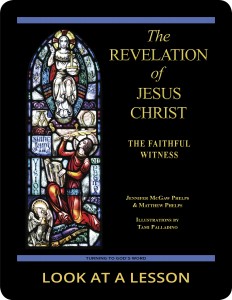 The Revelation of Jesus Christ: The Faithful Witness, a 23-lesson Catholic Bible study with an imprimatur, examines ways in which our traditional Christian view of heaven is built on Hebrew apocalyptic visions recorded in the Old Testament. This recently revised study includes maps and additional commentary and takes a close look at the role of the prophets in present-day Christianity. Illustrations by Tami Palladino depict the often-misunderstood images in the book of Revelation. Click on the book’s cover to view a sample lesson.
The Revelation of Jesus Christ: The Faithful Witness, a 23-lesson Catholic Bible study with an imprimatur, examines ways in which our traditional Christian view of heaven is built on Hebrew apocalyptic visions recorded in the Old Testament. This recently revised study includes maps and additional commentary and takes a close look at the role of the prophets in present-day Christianity. Illustrations by Tami Palladino depict the often-misunderstood images in the book of Revelation. Click on the book’s cover to view a sample lesson.
start a Turning to God’s Word Bible study
 Thank you for your interest in The Gospel According to John: An Encounter with Grace & Truth.
Thank you for your interest in The Gospel According to John: An Encounter with Grace & Truth.  Information about beginning a Turning to God’s Word Bible study can be found at start a Bible study. Tami, Matthew, and I are available to answer questions and offer support. Contact us if you’d like to start one of our studies or have your schedule listed with other TtGW study groups on our website. —Jennifer
Information about beginning a Turning to God’s Word Bible study can be found at start a Bible study. Tami, Matthew, and I are available to answer questions and offer support. Contact us if you’d like to start one of our studies or have your schedule listed with other TtGW study groups on our website. —Jennifer
*There are seven deuterocanonical books in the Old Testament—the Books of Tobit, Judith, Wisdom, Sirach, Baruch, and First and Second Maccabees, as well as some passages in the Books of Esther and Daniel. Protestants usually refer to these works as “apocryphal,” a word that means “outside the (Protestant) canon” because they’re excluded from most Protestant Bibles. The word “deuterocanonical” means “second canon”; Catholics use that word to refer to any section of the Catholic Old Testament for which there are no extant, or existing, Hebrew manuscripts. All of the deuterocanonical books appear in the Septuagint, the earliest remaining versions of which date to the 1st century B.C. This Greek translation of the Old Testament was in common use by Jews at the time of Jesust. Learn more by reading How Do Catholic & Protestant Bibles Differ?
Turning to God’s Word printed Bible studies use the 2006 Revised Standard Version Second Catholic Edition (RSV2CE) translation for all Scripture references except those to the Psalms, which are taken from The Abbey Psalms and Canticles, prepared by the Benedictine monks of Conception Abbey and published in 2020 by the United States Conference of Catholic Bishops (USCCB). All Scripture links for the online study pages for The Gospel According to John: An Encounter with Grace & Truth are to the 1966 Revised Standard Version Catholic Edition (RSVCE) translation. The New International Version (NIV) audio recordings follow the same chapter and verse numbering as the RSV Catholic translations, but the NIV translation doesn’t include the deuterocanonical books and passages.
The 1966 RSVCE uses archaic pronouns and verb forms such as “thee,” “thou,” “didst” in the Psalms and in direct quotations attributed to God. The 2006 RSV2CE replaces these with more accessible English. The few significant translation changes in the RSV2CE include rendering almah as “virgin” in the Book of Isaiah 7:14 and restoring the term “begotten” in the Gospel According to John 3:16.
Numbering varies for some passages in this Bible study. Turning to God’s Word studies (print and digital) follow the numbering in the Revised Standard Version Catholic translations (RSV2CE and RSVCE). Discrepancies in the New American Bible Revised Edition (NABRE) are noted in the Index of Scripture Citations in the study book and the online sample.
 You can learn more about the Psalms by viewing a sample lesson from the Turning to God’s Word Catholic Bible study Sing a New Psalm: Communicating with God Through the Prayers of the Church—Volume I: Lauds & Vespers. The second part of that study, Sing a New Psalm: Communicating with God Through the Prayers of the Church—Volume II: Vigils, Day Prayer & Compline, is scheduled for publication in 2025. Some verse numbers may vary in different translations of the Psalms.
You can learn more about the Psalms by viewing a sample lesson from the Turning to God’s Word Catholic Bible study Sing a New Psalm: Communicating with God Through the Prayers of the Church—Volume I: Lauds & Vespers. The second part of that study, Sing a New Psalm: Communicating with God Through the Prayers of the Church—Volume II: Vigils, Day Prayer & Compline, is scheduled for publication in 2025. Some verse numbers may vary in different translations of the Psalms.
